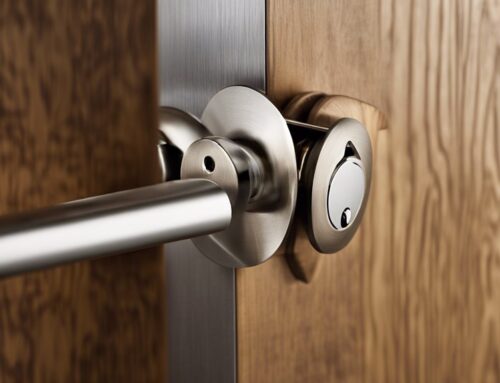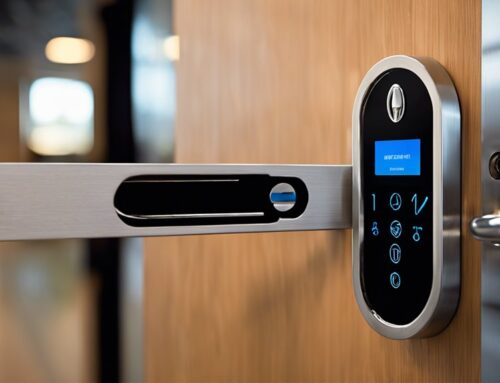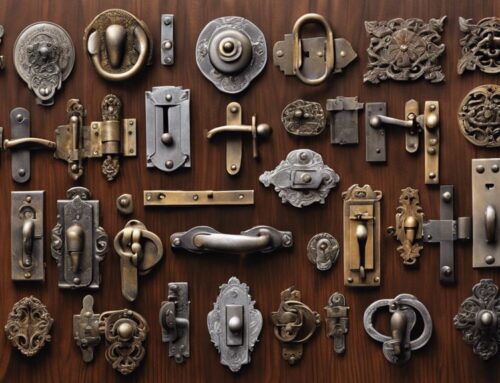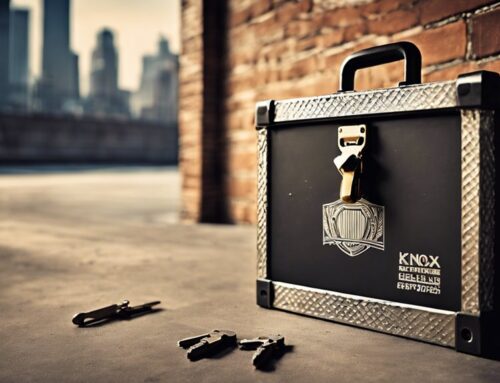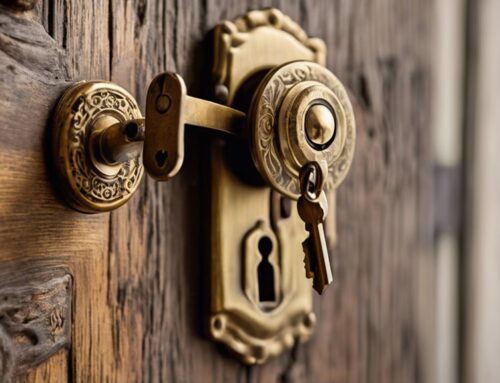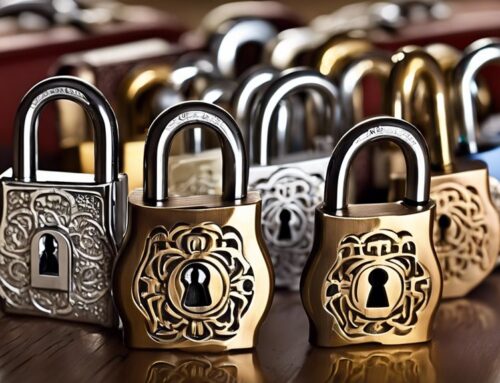Founded in 1818, Chubb Locks epitomizes a legacy of uncompromised security. As part of the ASSA ABLOY Group, it continually innovates with high-security locks, electronic access control, and biometric systems. Advanced features like anti-pick pins and remote access enhance both residential and commercial security. Renowned for its detector lock and a Royal Warrant, Chubb has become the trusted choice for banks and government institutions. Continual advancements like AI-driven threat detection and smart home integrations guarantee top-tier protection. For deeper insights on their cutting-edge solutions, continue your exploration further.
Key Takeaways
- Chubb Locks has a rich history of security innovation, starting with the invention of the detector lock in 1818.
- Known for high-security locks, electronic access control systems, and fire-resistant safes, Chubb Locks offers diverse, reliable security solutions.
- Awarded a Royal Warrant in 1851, Chubb Locks is trusted by government institutions and banks for its security excellence.
- Advanced features like biometric authentication and remote access control enhance both security and convenience for modern users.
- Chubb Locks prioritizes sustainability and community engagement, earning recognition for its corporate social responsibility initiatives.
Introduction to Chubb Locks
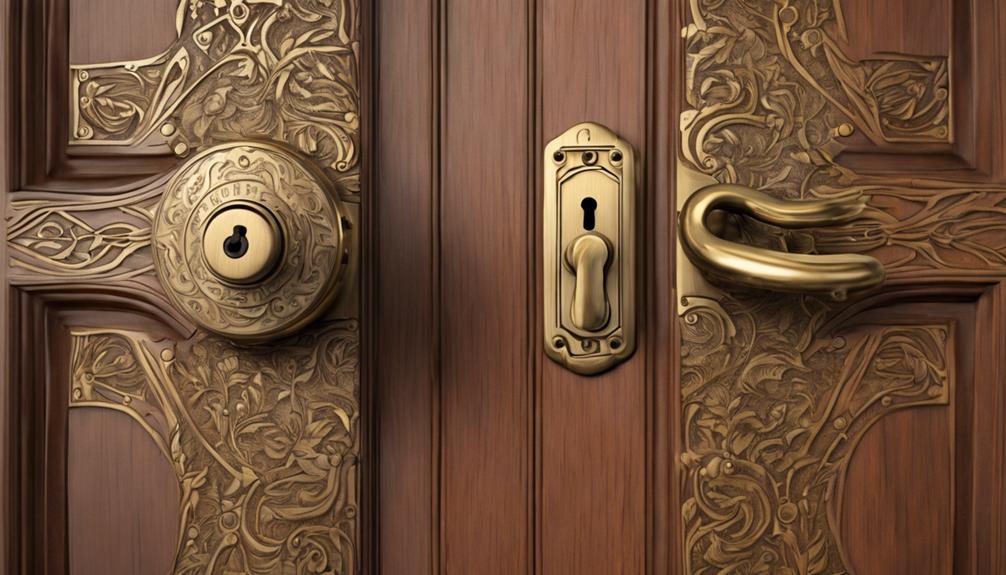
You’ll find Chubb Locks at the forefront of the lock industry, renowned for their innovation and reliability. Their mission is to provide cutting-edge security solutions while maintaining the highest standards of integrity and performance. With a vision to continuously lead in security technology, Chubb Locks remains committed to safeguarding your most valuable assets.
Overview of Chubb Locks’ position in the lock industry
Founded in 1818, Chubb Locks has consistently set industry benchmarks with innovations like the unpickable detector lock, establishing itself as a leader in both traditional and modern security solutions. By integrating advanced cylinder mechanisms and electronic keyless entry systems, Chubb addresses diverse security needs. Their extensive portfolio includes deadbolts, mortice locks, and sophisticated keyless systems, making them a versatile choice for residential and commercial applications. Now a part of the ASSA ABLOY Group, Chubb leverages cutting-edge technologies to guarantee unmatched protection. Their commitment to innovation and reliability sets them apart, offering you the liberation from security concerns through robust, dependable solutions. Chubb Locks continues to define excellence in a competitive lock industry.
Mission and vision of Chubb Locks
Building on its rich heritage and innovative spirit, Chubb Locks’ mission is to provide unparalleled security solutions that guarantee the utmost protection and peace of mind for its clients. To combat evolving security threats, Chubb Locks leverages cutting-edge technology and a deep understanding of security dynamics. Their vision encompasses:
- Revolutionizing Security: Continuously advancing lock mechanisms and electronic access systems.
- Global Protection: Ensuring safety across diverse sectors, from residential to high-security institutions.
- Client Trust: Building lasting relationships through reliability and excellence.
- Sustainability: Innovating with eco-friendly materials and processes.
Chubb Locks doesn’t just react to security threats; they anticipate and neutralize them, providing you a liberated peace of mind.
Founding and Historical Development
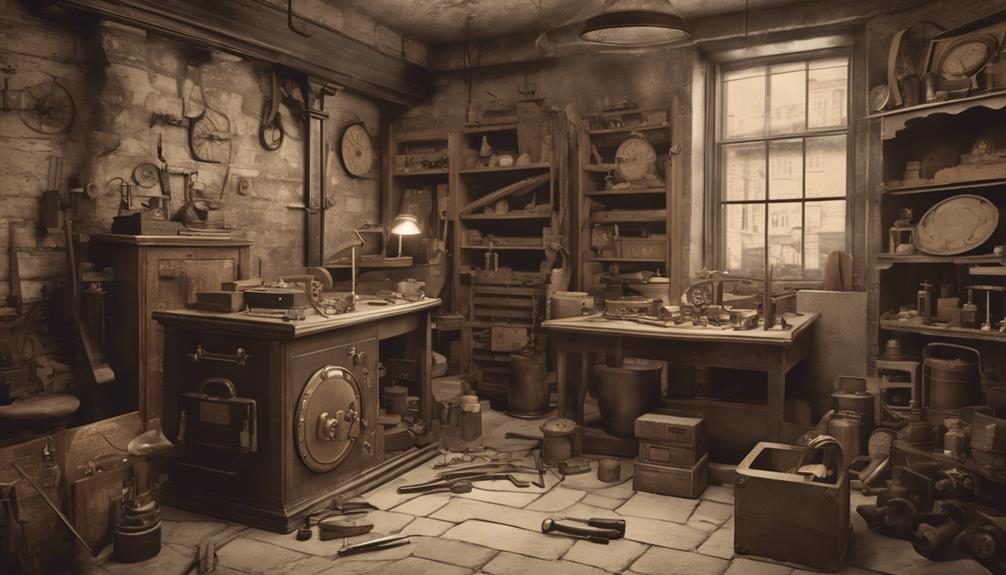
You’ll find Chubb Locks’ origins in 1818 Wolverhampton, where Jeremiah and Charles Chubb introduced the groundbreaking unpickable detector lock. This innovation secured them a special license from King George IV in 1823, establishing their reputation as the premier security provider. Over the years, Chubb Locks has evolved, incorporating high-security systems and expanding its product range under key acquisitions like that of United Technologies Corporation in 2000.
History and founding of Chubb Locks
In 1818, Jeremiah and Charles Chubb revolutionized the security industry with their invention of the detector lock, establishing a legacy of unparalleled safety standards. Jeremiah Chubb’s innovative design could detect unauthorized attempts to pick or tamper with the lock, setting a new benchmark in security solutions. Their contribution to the field was recognized with a special license from King George IV in 1823.
Consider these milestones in Chubb Locks’ early history:
- 1818: Invented the groundbreaking detector lock.
- 1823: Awarded a royal license for lock innovations.
- Exclusive Supplier: Became the sole lock provider for the General Post Office and His Majesty’s Prison Service.
- 1851: Designed a secure display case for the Koh-i-Noor diamond.
These achievements highlight Chubb’s enduring commitment to security excellence.
Key milestones in the company’s development
Examining the evolution of Chubb Locks, one observes a series of strategic milestones that have cemented its reputation as a leader in security innovations since its inception in 1818. Founded by Jeremiah and Charles Chubb in Wolverhampton, the invention of the detector lock that same year revolutionized security systems. By 1851, Chubb Locks had earned a Royal Warrant from Queen Victoria, solidifying its elite status. Expanding its clientele over the years to include government buildings, banks, and institutions, Chubb Locks consistently emphasized security excellence. Acquired by United Technologies Corporation in 2000, the company continued to innovate, ensuring high-quality security solutions under new ownership. These milestones reflect Chubb Locks’ unwavering commitment to security and innovation.
Significant historical figures
Jeremiah and Charles Chubb, through their groundbreaking invention of the detector lock in 1818, laid the foundation for what would become a pivotal name in the security industry. Jeremiah Chubb’s innovative design was awarded a special license by King George IV in 1823, solidifying its unmatched security.
To appreciate their impact, consider these milestones:
- Royal Warrant: Received from Queen Victoria in 1851.
- Exclusive Supplier: Sole lock supplier to the General Post Office and His Majesty’s Prison Service.
- Unpickable Design: The detector lock remained unpicked until the Great Exhibition of 1851.
- Global Leader: From Wolverhampton to worldwide, Chubb Locks evolved into a leader in high-security solutions.
Their legacy underscores a relentless pursuit of security excellence.
Product Offerings and Specializations

You’ll find Chubb Locks’ product offerings encompass a diverse array of security solutions, from robust deadbolt and mortice locks to sophisticated keyless entry systems. Each product is engineered with advanced features like anti-pick pins and anti-drill plates, ensuring unparalleled protection. Specializing in high-grade materials such as solid brass and stainless steel, Chubb Locks delivers both durability and top-tier security.
Comprehensive overview of Chubb Locks’ product lines
With a robust lineup that includes deadbolt locks, mortice locks, keyless entry systems, padlocks, and master key systems, Chubb Locks leverages high-quality materials such as solid brass and stainless steel to guarantee unparalleled durability and security. These locks are designed with advanced security features like anti-pick pins and anti-drill plates, ensuring that your spaces remain secure against unauthorized access. Here’s a streamlined overview of their product offerings:
- Deadbolt Locks: Enhanced with anti-tamper mechanisms for maximum security.
- Mortice Locks: Precision-engineered for superior resistance and reliability.
- Keyless Entry Systems: Seamless integration of technology for convenience and security.
- Padlocks: Portable security solutions with robust construction.
Embrace the liberation of exceptional security with Chubb Locks.
Highlighting key products and their unique features
Focusing on Chubb Locks’ key products, let’s analyze the unique features that distinguish their deadbolt locks, mortice locks, keyless entry systems, padlocks, and master key systems in the security industry. Chubb’s deadbolt locks offer anti-pick pins and anti-drill plates, enhancing protection against forced entry. Their mortice locks stand out for their durability, making them ideal for both residential and commercial use. Keyless entry systems provide convenience with PIN codes and biometric recognition, ensuring secure access control. Chubb’s padlocks are perfect for outdoor asset protection, offering robust security solutions. Master key systems streamline access management across multiple entry points.
| Product | Unique Features | Applications |
|---|---|---|
| Deadbolt Locks | Anti-pick pins, anti-drill plates | Enhanced security |
| Mortice Locks | Durability, dual-use suitability | Residential, commercial properties |
| Keyless Entry Systems | PIN codes, biometric recognition | Secure access control |
Innovations in lock design and security
Chubb Locks has continually set benchmarks in lock design and security by integrating cutting-edge technologies and innovative engineering solutions tailored to meet the diverse needs of modern security applications. Their legacy began with the groundbreaking detector lock in 1818, an innovation that set the standard for tamper detection. Today, Chubb Locks offers a diverse range of high-security solutions designed for ultimate protection and reliability.
Here are some key innovations:
- High-Security Locks: Engineered to withstand forced entry and tampering.
- Electronic Access Control Systems: Guarantee precise and flexible access management.
- Fire-Resistant Safes: Shield critical documents and valuables from fire damage.
- Surveillance Solutions: Provide thorough monitoring and security integration.
With a focus on excellence, Chubb Locks continues to lead in security advancements.
Technological Innovations
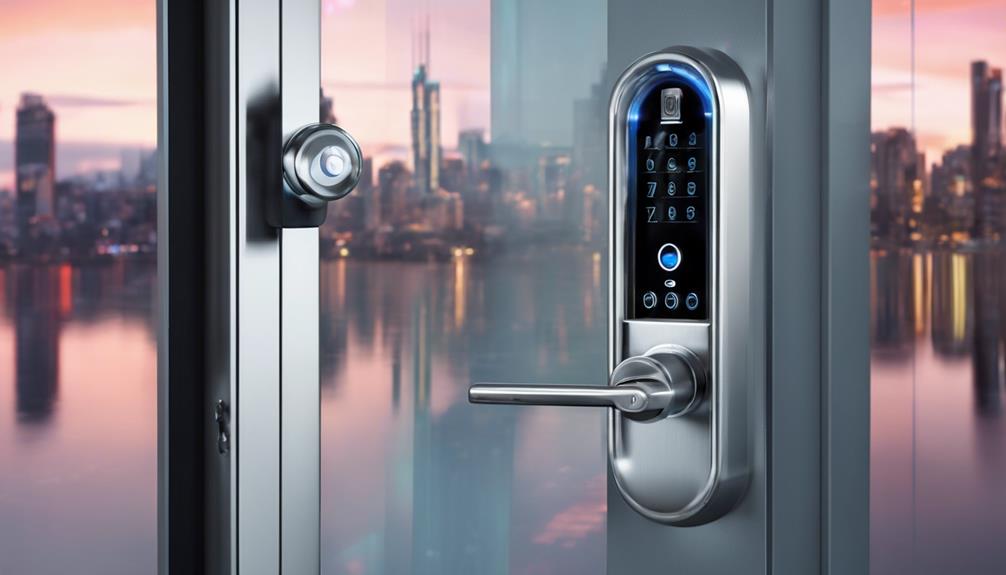
You’ll appreciate the advanced cylinder mechanisms in Chubb Locks that greatly enhance tamper resistance and overall security. Their electronic keyless entry systems and biometric authentication technologies provide both convenience and robust access control. Let’s examine how these technological innovations translate to real-world applications and case studies, solidifying Chubb Locks’ reputation for uncompromised security.
In-depth look at Chubb Locks’ technological advancements
By leveraging advanced cylinder mechanisms and integrating electronic keyless entry systems, Chubb Locks guarantees unparalleled security and convenience in modern access control. Their commitment to innovation is evident in several key technological advancements:
- Advanced Cylinder Mechanisms: Enhanced security features to thwart unauthorized access.
- Electronic Keyless Entry: Seamless access control, eliminating the need for physical keys.
- Biometric Authentication: Utilizing fingerprint and facial recognition for heightened security in homes and businesses.
- Remote Access Control: Manage and monitor entry points via smartphone apps, offering ultimate convenience.
These innovations affirm Chubb Locks’ position at the cutting edge of access control technology, empowering you to secure your premises with confidence and ease. By adopting these technologies, you’re embracing a future of liberated, secure living.
How these technologies enhance security
These cutting-edge technologies greatly enhance security by making unauthorized access exceedingly difficult while granting you unprecedented control over entry points. Chubb Locks’ advanced cylinder mechanisms offer uncompromising security with intricate pin configurations that resist picking. The integration of electronic keyless entry systems guarantees effective access control, allowing you to manage entry points with precision. Biometric authentication adds another layer of security, utilizing unique physical characteristics to verify identity. Additionally, smart home integration provides both enhanced security and convenience, enabling remote monitoring and control.
| Feature | Description | Benefit |
|---|---|---|
| Advanced Cylinder Mechanisms | Intricate pin configurations | Resists picking |
| Electronic Keyless Entry | Convenient access control | Precision in managing access |
| Biometric Authentication | Uses unique physical characteristics for verification | Adds an extra layer of security |
| Smart Home Integration | Remote monitoring and control | Enhanced security and convenience |
These innovations guarantee your home or business receives the highest level of security.
Real-world applications and case studies
Frequently in real-world applications, Chubb Locks’ technological innovations showcase their effectiveness through enhanced security measures in both residential and commercial settings. For instance, their advanced cylinder mechanisms provide superior resistance to tampering, enhancing overall security. They’re also integrating electronic keyless entry systems for convenient access control.
Consider these applications of Chubb Locks:
- Smart homes: Remote access control via smartphone apps lets you manage security from anywhere.
- Commercial premises: Customizable access control solutions meet unique business security needs.
- Biometric systems: Personalized entry options guarantee only authorized personnel gain access.
- Residential security: Keyless entry systems simplify access without compromising safety.
Market Reach and Global Influence

You’ll appreciate how Chubb Locks’ strategic expansion has cemented its global presence, making it a key player in markets across Europe, Asia, and the Americas. By leveraging strategic business partnerships and adapting to regional security demands, Chubb Locks has solidified its influence in these areas. Let’s examine how these factors contribute to their market reach and global dominance.
Analysis of Chubb Locks’ global presence
Chubb Locks’ extensive market reach and global influence are evident through their widespread use in critical infrastructure sectors like government buildings and financial institutions across various countries. Their global reach is a reflection of their innovative security systems and industry standards. Since their acquisition by United Technologies Corporation in 2000, they’ve expanded internationally, maintaining a reputation for excellence.
You can see their influence in:
- Government facilities: High-security solutions tailored for national security.
- Financial institutions: Robust systems to safeguard sensitive data and assets.
- Corporate offices: Advanced security measures for business continuity.
- Healthcare institutions: Reliable protections ensuring patient and staff safety.
Chubb Locks continue to cater to a diverse global clientele, showcasing their commitment to uncompromised security.
Key markets and regions where Chubb Locks is prominent
Recognizing their global influence, you’ll find Chubb Locks prominently featured in key markets such as the UK, US, Europe, and Asia, where their high-security solutions cater to both commercial and industrial sectors. Known for ensuring the integrity of commercial properties, Chubb Locks has solidified its standing as a trusted supplier for government buildings, banks, and institutions, particularly in the UK. By leveraging a legacy of innovation and reliability, Chubb Locks has expanded its reach, becoming a preferred choice for businesses seeking robust security solutions worldwide. Their expertise in tailored security measures enables them to meet the diverse needs of different regions, reinforcing their position as a leading player in the global security industry.
Strategic business partnerships
Leveraging strategic business partnerships, Chubb Locks has expanded its market reach and solidified its global influence in the security solutions industry. These alliances have been instrumental in fostering innovation and reliability. Here’s how:
- Collaborations with Industry Leaders: By teaming up with top-tier security firms, Chubb has enhanced its product offerings and market penetration.
- Joint Ventures with Technology Firms: These ventures have driven advancements in access control systems, making Chubb a tech-forward security provider.
- Government Agency Relationships: Trusted partnerships with government bodies have cemented Chubb’s reputation for reliability and compliance.
- Security Integrator Partnerships: Working with integrators has enabled Chubb to provide thorough, tailored solutions to meet diverse client needs.
Strategic partnerships have undeniably propelled Chubb Locks to the forefront of the security industry.
Customer Reviews and Satisfaction

When reviewing customer feedback, you’ll find that Chubb Locks consistently earn high marks for their robust quality and reliability. Users frequently commend the advanced security features and durability, enhancing overall peace of mind. Notable installations and success stories further underscore the brand’s consistent performance and ability to meet stringent security demands.
Summary of customer feedback and reviews
Customer reviews unequivocally attest to Chubb Locks’ unmatched reliability and durability in securing both residential and commercial properties. When you analyze the feedback, it becomes clear why Chubb remains a market leader.
- Reliability of Chubb: Clients consistently commend the locks for their dependability, ensuring peace of mind.
- Advanced Security Features: Anti-pick pins and anti-drill plates receive high praise for thwarting potential breaches.
- User-Friendly Design: Users appreciate the seamless operation and intuitive design of Chubb Locks.
- Long-Lasting Performance: Many reviews highlight the locks’ longevity, a reflection of Chubb’s meticulous manufacturing standards.
These aspects reflect how Chubb integrates technical excellence with user-centric design, providing unparalleled security solutions.
Common praises and criticisms
In evaluating the common praises and criticisms of Chubb Locks, you’ll find a consensus on their exceptional security features and a few concerns primarily centered around their premium pricing. Customers consistently laud Chubb Locks for their robust security solutions, citing advanced technology and effective protection against unauthorized access. The brand’s long-standing reputation and reliability are frequently highlighted in positive reviews. Users appreciate the ease of use and durability, reinforcing Chubb’s status as a trusted industry leader. However, some critiques focus on the higher cost, suggesting that while the quality is undeniable, the price point may limit accessibility. Overall, the high satisfaction ratings reflect Chubb Locks’ commitment to delivering uncompromised security solutions for both homes and businesses.
Success stories from notable installations
Numerous case studies and customer testimonials highlight the exceptional performance of Chubb Locks in high-security installations, showcasing their unparalleled effectiveness in both residential and commercial settings. Satisfied users frequently emphasize the brand’s reliable security features and robust construction. Here are some standout reviews:
- Residential Security: Homeowners commend Chubb Locks for providing peace of mind, citing their ability to deter potential intruders effectively.
- Commercial Applications: Business owners appreciate the advanced technology and ease of use, which seamlessly integrates with existing security systems.
- Durability: Customers note the locks’ long lifespan, even under constant use, which underscores their durable construction.
- Customer Loyalty: Many have expressed unwavering trust in Chubb Locks, resulting in a loyal customer base that values uncompromised security.
These success stories attest to Chubb Locks’ industry-leading security solutions.
Corporate Responsibility and Community Engagement

You’ll find that Chubb Locks integrates sustainability and social responsibility into its core operations, evidenced by its extensive community projects and social impact efforts. The company’s strategic partnerships and initiatives have garnered numerous recognitions and awards for corporate social responsibility (CSR). Analyzing these aspects reveals a robust commitment to ethical business practices and environmental stewardship.
Chubb Locks demonstrates unwavering commitment to sustainability through cutting-edge eco-friendly manufacturing practices and materials. By integrating advanced technologies, they’ve minimized environmental impact while maintaining product integrity. Chubb Locks is dedicated to reducing waste and energy consumption, ensuring that their operations align with global environmental standards. Their initiatives reflect a profound understanding of corporate responsibility and societal influence.
Here’s how Chubb Locks excels in sustainability:
- Eco-friendly materials: Utilizing recyclable and sustainable materials in their products.
- Energy-efficient processes: Implementing energy-saving techniques in manufacturing.
- Waste reduction: Streamlining processes to minimize industrial waste.
- Sustainable sourcing: Partnering with suppliers who adhere to environmental best practices.
These measures prove Chubb Locks as a leader in eco-conscious innovation.
Driven by a deep sense of corporate responsibility, the company actively supports local initiatives and charities, reinforcing their commitment to social impact and sustainable practices. Chubb Locks prioritizes community engagement through strategic investments in community projects that foster relationships with stakeholders and residents. By integrating social responsibility into their core values, they drive initiatives that benefit both society and the environment. Their contributions extend beyond providing security solutions, as they aim to make a positive difference in the communities they serve. Through these efforts, Chubb Locks not only enhances social welfare but also promotes sustainable practices, ensuring their legacy is one of positive societal impact. Your liberation from traditional security paradigms starts with their unwavering community commitment.
Recognitions and awards for CSR
Demonstrating an unwavering commitment to community engagement, the numerous recognitions and awards Chubb Locks has garnered for its Corporate Social Responsibility (CSR) initiatives underscore the company’s impactful contributions to society. Through strategic CSR programs, they’ve not only upheld ethical business practices but also fostered sustainable development. Here are some key awards reflecting their dedication:
- Sustainability Excellence Award – For groundbreaking sustainable practices.
- Philanthropy Leadership Award – Acknowledging significant philanthropic endeavors.
- Ethical Business Award – For maintaining high standards of integrity and transparency.
- Community Impact Award – Celebrating their positive societal contributions.
These accolades aren’t just badges of honor; they’re a reflection of Chubb Locks’ values and their unwavering drive to make a meaningful difference.
Future Directions and Innovations

As you look to the future of Chubb Locks, anticipate groundbreaking advancements in electronic keyless entry systems and biometric authentication for superior access control. Their integration with smart home ecosystems and customizable solutions for commercial applications underscore Chubb Locks’ dedication to security innovation. By aligning with industry trends and focusing on technological goals, Chubb Locks guarantees they remain at the cutting edge of security solutions.
Upcoming products and technological goals
Chubb Locks is set to revolutionize the security industry by integrating advanced biometric authentication technology into their upcoming product lineup. By focusing on smart lock systems, the company aims to provide enhanced security and seamless integration with various smart home ecosystems. You can expect the following exciting developments:
- Biometric Authentication: Utilizing fingerprint and facial recognition for unparalleled security.
- Smart Home Integration: Ensuring compatibility with leading smart home platforms for a unified user experience.
- Customizable Access Control: Tailoring security solutions to meet the unique needs of residential and commercial settings.
- Remote Access Capabilities: Enabling users to monitor and manage locks through intuitive smartphone apps.
Chubb Locks remains dedicated to pioneering cutting-edge security solutions to liberate your home and business environments.
Chubb Locks’ vision for the future
With an unwavering commitment to advancing security technology, the future vision for Chubb Locks encompasses innovative solutions like blockchain-based access control and AI-driven threat detection. You’ll find Chubb Locks integrating biometric authentication and electronic keyless entry systems to meet evolving security requirements. Their focus on smart home integration guarantees compatibility with various ecosystems, allowing remote access control via smartphone apps. Chubb’s customizable access control solutions cater to commercial and industrial settings, upholding industry standards. Reliability and durability remain paramount, with features like anti-pick pins and anti-drill plates. By dispelling myths of inaccessibility, Chubb Locks offers secure, stylish, and cost-effective options for residential use, ensuring a future where advanced security is accessible to all.
Industry trends and Chubb Locks’ strategic adaptations
Building on their vision for the future, industry trends in security technology have prompted Chubb Locks to strategically embrace advancements like AI-driven threat detection and blockchain-based access control. These innovations guarantee Chubb remains at the forefront of excellent security solutions. Here’s how they’re adapting:
- Electronic Keyless Entry Systems: Eliminates traditional keys, offering streamlined access.
- Biometric Authentication: Provides secure, personalized access through fingerprint or retinal scans.
- Smart Home Integration: Allows remote access and monitoring via smartphone apps, enhancing convenience.
- Customizable Access Control Solutions: Tailored for various industries, ensuring specific security needs are met.
Conclusion: Sustaining a Legacy of Security
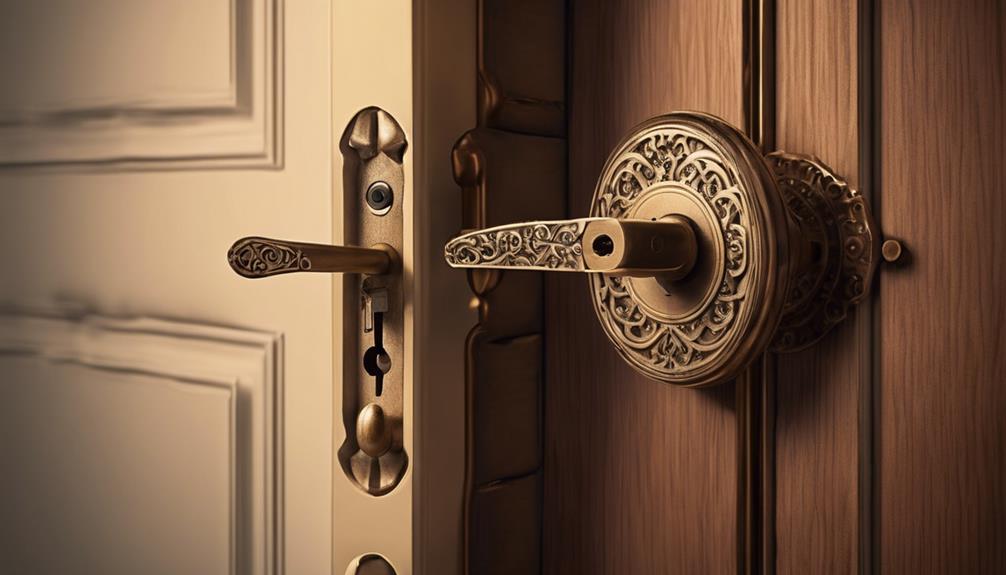
You’ve seen how Chubb Locks has pioneered advancements in security technology and maintained industry leadership. Looking ahead, expect further innovation in integrated security systems and smart access solutions. As you reflect on Chubb Locks’ storied history, their commitment to safeguarding assets globally remains unwavering.
Recap of Chubb Locks’ contributions to the lock industry
Chubb Locks has consistently set industry benchmarks by pioneering advanced security solutions like the detector lock, securing a Royal Warrant, and evolving into a leader in high-security and electronic access systems. Locks have long been essential in safeguarding assets and ensuring privacy, but Chubb’s contributions have redefined the standards of security. Here’s a brief recap of their key milestones:
- 1818: Introduction of the detector lock, revolutionizing tamper detection.
- 1851: Receipt of the Royal Warrant by Queen Victoria, establishing prestige.
- 2000: Acquisition by United Technologies Corporation, broadening product offerings.
- High-Security Evolution: From mechanical locks to cutting-edge electronic access systems.
Chubb Locks’ relentless innovation and commitment to quality have cemented its legacy in the lock industry.
Future prospects and planned developments
As Chubb Locks continues to shape the security landscape, future prospects focus on integrating biometric authentication and electronic keyless entry systems to meet evolving demands. You’ll appreciate the seamless integration with smart home ecosystems, granting remote access control and monitoring from anywhere. For businesses, Chubb Locks offers customizable access control solutions tailored to your specific security needs across various industries. The commitment to reliability and durability guarantees these innovations provide long-lasting performance in both residential and commercial settings. By prioritizing technological advancements and customer satisfaction, Chubb Locks sustains its legacy of unmatched security solutions. These developments empower you with greater control and peace of mind, ensuring that your security needs are met with cutting-edge precision and dependability.
Final reflections on Chubb Locks’ legacy
With a storied history of pioneering advancements, the enduring legacy of Chubb Locks epitomizes reliability and cutting-edge security technologies. As you reflect on this legacy, consider how Chubb Locks has consistently delivered unparalleled security solutions. Their commitment to excellence and innovation has sustained their prominence in the industry.
Here’s how Chubb Locks has maintained its legacy:
- Acquisition by United Technologies Corporation in 2000, marking a pivotal moment of growth.
- Expansion of product offerings to include advanced access control, alarm systems, surveillance, and fire protection.
- Respected name under Raytheon Technologies’ ownership, ensuring continued trust and reliability.
- Global commitment to safety, consistently safeguarding assets worldwide.
Chubb Locks’ unwavering dedication to security guarantees its legacy will endure.
Frequently Asked Questions
What Happened to Chubb Locks?
Chubb Locks underwent significant company evolution after being acquired by ASSA ABLOY in 2000 and later by Raytheon Technologies. Under new ownership, it expanded its product offerings to include access control, alarm systems, surveillance, and fire protection. This strategic growth enhanced its global reach and maintained its reputation within the security industry. You can trust Chubb Locks to deliver cutting-edge solutions for thorough protection and peace of mind.
Are Chubb Locks Secure?
Oh, you’re worried if Chubb Locks are secure? Let’s be real, if royal warrants and anti-drill plates don’t scream security, what will? With key features like anti-pick pins and meticulous manufacturing, Chubb Locks are a fortress for your doors. Their reliability and user-friendly design mean you won’t need a PhD to secure your home. So, go ahead, liberate yourself from security worries.
What Are the Problems With Traditional Locks?
Traditional locks have key vulnerabilities. They’re susceptible to picking, bumping, and various forced entry methods. Without advanced security features like anti-pick pins or anti-drill plates, traditional locks can’t match the resistance to tampering and manipulation offered by modern high-security systems. Their outdated technology compromises the overall security of your property, leaving it exposed to sophisticated break-in techniques. You deserve better protection for your assets.
What Is the History of Chubb Locks?
Imagine the clinking of metal as Jeremiah and Charles Chubb patented their unpickable detector lock in 1818, revolutionizing security. Chubb Locks evolved into Chubb & Sons Lock and Safe Company, setting industry standards. Acquired by ASSA ABLOY, they’ve embraced advanced cylinder mechanisms and electronic keyless entry systems. Their history showcases continuous innovation in robust deadbolt and mortice locks, integrating biometric authentication and smart home tech for ultimate security.

